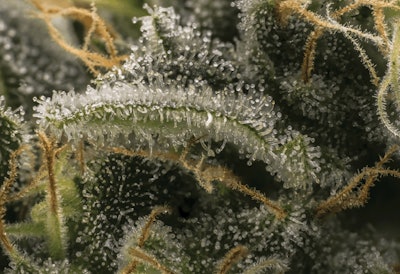

The debate over THC levels and hot hemp crops has dominated the industry in its first two years of federal legalization. The 0.3% legal THC limit in the U.S. strains cultivation skills and imposes great risk on anyone willing to venture into this new American marketplace.
But that marquee stat line—0.3%—tells an incomplete story. It’s not as though growers can simply monitor THC levels and stop the plant from producing this infinitesimal cannabinoid on the spot. If only!
Rather, the complex biochemistry behind THC development is part of a vast and microscopic metabolic network in the Cannabis sativa L. plant that researchers are only beginning to grasp. One of those researchers is Michael Gutensohn, a plant biologist specializing in biochemistry and genetics at West Virginia University (WVU).
In June, he and a team of researchers were awarded a $200,000 U.S. Department of Agriculture (USDA) foundational grant. The grant, which is meant to develop a baseline of information, will support study of the terpene-cannabinoid metabolic network and how, specifically, it works.
Learning about the development of THC—and how to prevent licensed crops from running hot—is one likely byproduct of his comprehensive study. And it’s an important one. Hemp farmers across the globe know this; as a tightly regulated industry wrapped in legal definitions and compliance concerns, hemp is fraught with challenges from the jump. One step over the 0.3% THC line in late summer can ruin a farmer’s investment and potentially scare him or her away from the market entirely.
“There is an economic risk there, and that’s of course part of what drives our research as well,” Gutensohn says. “We need to address that [hot crop] problem because it’s too much of an economic gamble not knowing what’s going on there. We know way too little about it so far.”
According to Gutensohn, the ratio of THC development to other cannabinoids and terpenes is not a simple 1:1 relationship. As cannabidiol (CBD) content increases, yes, so too does THC content, but that is not helpful for farmers hoping to increase CBD or other cannabinoid yields for a wildly competitive marketplace. It is not rooted in any clear understanding of how this plant works, he adds.
Instead, these chemical compound relationships are more algorithmic, strung together by shifting variables.

“There’s a bit of a debate going on in the hemp research field over what is more responsible for setting up a variety to be potentially more or less prone to having a THC spike,” Gutensohn says. “To summarize it, I think there’s no doubt in the field that there’s definitely a cross-talk between genetics and environment. It’s clear that some varieties might be a little bit more prone to having THC spikes, and it could be that this is correlating with the CBD or CBG [cannabigerol] content. But if we reduce it to just that, I think that would be a little bit too simplistic. As you can see in our research, we think that the environment also plays a huge factor in that.”
Part of WVU’s mission, as a land grant university, is to conduct research that benefits farmers in the real agricultural world—both in West Virginia, where 283 licensed farmers applied to grow 2,884 acres of hemp this year, according to the West Virginia Department of Agriculture, and beyond. But hot crops are only one legal component of what is otherwise a remarkably complicated plant species.
To understand hot crops and the genetic precursors that contribute to THC spikes, you need to go deeper.
Focus of the Research
“We’re going to look at the whole underlying genetic regulation of how these [hemp] products are formed and how this [metabolic] network responds to any of these perturbations, these environmental stresses,” Gutensohn says, describing his two-year study. “That will hopefully tell us, ‘This is how this network works and how it’s regulated.’ And then we can hopefully come to a certain understanding of certain regulations there that you can target in breeding or genetic engineering.”
The USDA grant is aimed at the terpene-cannabinoid metabolic network, an interconnected system that produces the compounds that, in certain market segments, make hemp as valuable as it is. Think of cannabinoids such as CBD or CBG, and well-known terpenes such as myrcene or linalool. These compounds are linked.
“It’s not just one linear pathway that produces one compound,” Gutensohn says. “Nowadays, in biochemistry, we understand more and more that a lot of these metabolic pathways are linked. What you do on one branch can very quickly have an effect on a lot of other things because of these intricate internal regulatory circuits. If we would just look at THC, we would probably miss a lot of other things going on there, and vice versa. If you just look at CBD and think that’s the only thing, well, you might overlook that you’re also affecting THC.”
Gutensohn points to geranyl diphosphate (GPP) as a metabolite precursor in Cannabis sativa L., a chemical branch point from which cannabinoids and terpenes spring into existence within the plant. This upstream precursor acts as an engine of biosynthesis, Gutensohn says, developing many of the chemical compounds that make cannabis so interesting to us. “These two groups of compounds, terpenes and cannabinoids, share [GPP] as a precursor, and, logically, we need to understand how the plant regulates how much of this metabolite develops into the one branch versus the other one,” he says.

So, why does Cannabis sativa L. form these compounds, anyway? That question is the foundation of Gutensohn’s research. By understanding the biological reason behind this network, he and his team can then begin to study it. By doing so, they can single out genetic characteristics that will give farmers a greater chance at increasing yields and optimizing plant health.
As an important aside, Cannabis sativa L. is rich in cannabinoids, terpenes and other volatile organic compounds all known as secondary metabolites. Terpenes and flavonoids create the plant’s unique scent. (Alternatively, think of terpene-heavy tomatoes or tulips.) Working in concert, these compounds help the pollination process and help the plant repel pests or attract beneficial insects to attack pests. They form an intricate support system for the plant’s reproduction and a dynamic defense system. They are central to the plant’s success.
These compounds also have certain properties, such as their anti-inflammatory and sedative qualities, that are commonly seen an beneficial to humans and pets. These qualities are attractive in a commercial landscape, making the delicate balance of cannabinoid development (including THC) an important algorithm for farmers to understand.
Environmental Stressors
And, as farmers know, a host of abiotic environmental stresses, such as heat, drought, and salinity, are all factors in how a cannabis plant develops its secondary metabolites. These environmental stresses may trigger the plant’s defense system or ignite a need to pollinate.
So, Gutensohn and his team are growing several varieties of hemp in the WVU greenhouse and in small grow rooms, controlling for each of those factors. One by one, with a constant nutrition regimen for each crop, the research team plans to run through different stresses that might spur different algorithmic responses.
Included among the WVU study’s subjects is a grain variety called Finola, the one hemp cultivar that has been genetically sequenced, according to Gutensohn. With a publicly available genome for the Finola variety, this USDA-funded research will be immediately applicable and widely understood by anyone working with that variety of the plant.
That’s the other side of this study: As we glean a greater understanding of the plant’s inner workings, we can tailor genetics to suit the plant’s needs in different climates and the market’s needs in different sectors (cannabinoid extraction, grain and fiber). Without this analysis, licensed farmers may be stuck in a trial-and-error cycle season after season.
USDA Funding
“The change in the farm bill and now the availability of funding by USDA and other federal funding agencies is a complete change in the game plan,” Gutensohn says. “It wasn’t that there was no interest in working with hemp before this; it was simply all our research was hampered before by the unavailability of funding.”
As of mid-October, the USDA website lists 77 active grant-funded research projects involving “industrial hemp” to one degree or another, a spectrum of studies that reels in millions of federal dollars.
Gutensohn’s grant runs through May 2022, with a perpetual harvest cycle carrying his team until then. By then, knowing the sheer velocity of this industry, more questions will surely arise. And the opportunities to provide answers will grow in time, as well.
Eric Sandy is the digital editor for Cannabis Business Times.
















